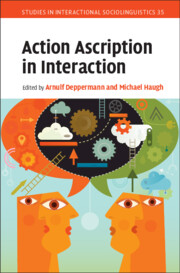Book contents
- Action Ascription in Interaction
- Studies in Interactional Sociolinguistics
- Action Ascription in Interaction
- Copyright page
- Contents
- Figures
- Tables
- Contributors
- Introduction
- Part I Constituents of Action Ascription
- 2 Temporal Organization and Procedure in Ascribing Action
- 3 The Micro-Politics of Social Actions
- 4 Action Ascription, Accountability and Inference
- 5 Attributing the Decision to Buy
- Part II Practices of Action Ascription
- Part III Revisiting Action Ascription
- Book part
- Index
- References
3 - The Micro-Politics of Social Actions
from Part I - Constituents of Action Ascription
Published online by Cambridge University Press: 17 February 2022
- Action Ascription in Interaction
- Studies in Interactional Sociolinguistics
- Action Ascription in Interaction
- Copyright page
- Contents
- Figures
- Tables
- Contributors
- Introduction
- Part I Constituents of Action Ascription
- 2 Temporal Organization and Procedure in Ascribing Action
- 3 The Micro-Politics of Social Actions
- 4 Action Ascription, Accountability and Inference
- 5 Attributing the Decision to Buy
- Part II Practices of Action Ascription
- Part III Revisiting Action Ascription
- Book part
- Index
- References
Summary
My starting point is that certain actions are ‘valued’ over others, in ways that are not restricted to pairs of possible actions (therefore not restricted to adjacency pairs). For instance, it may be regarded in certain corporate and political worlds as better to have ‘resigned’ than to have been fired. The micro-politics of social action is evident in the manoeuvres by which participants implement or avoid certain actions, always remembering that the relative value of an action is a situated attribute. I consider some of the systematic ways in which participants ‘position’ themselves with respect to certain action environments. From among the varied ways participants manoeuvre and position themselves regarding implementing and avoiding action, three stand out: (i) avoiding taking an action, in such a way that the other responds as though the (absent action) implication had been performed (other’s ascription to self of an action self might have been avoiding); (ii) disguising an action, through (mis)attributing to one’s own speech an action which may differ from the action that is thereby implemented (self-ascription); and (iii) treating a prior turn/action as having been what it was not officially designed to be/do (denying, disclaiming, ‘misattributing’ actions) (other-ascription).
Keywords
- Type
- Chapter
- Information
- Action Ascription in Interaction , pp. 57 - 80Publisher: Cambridge University PressPrint publication year: 2022
References
- 5
- Cited by

